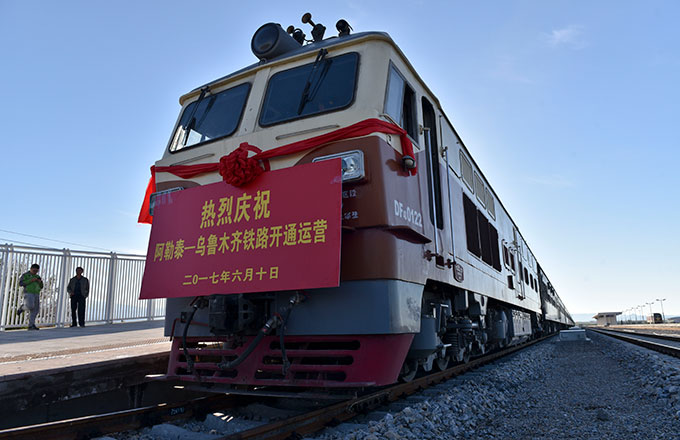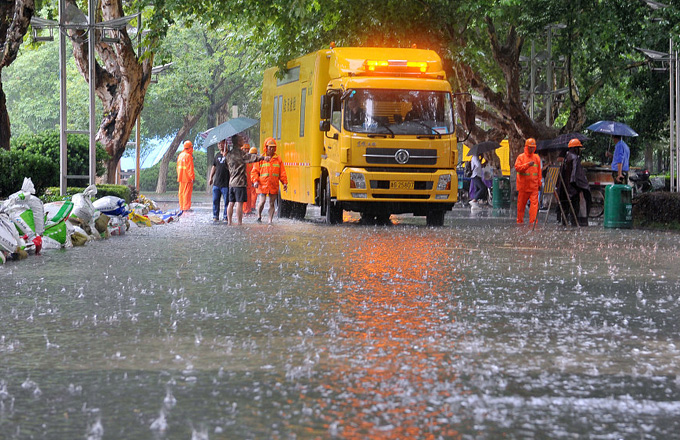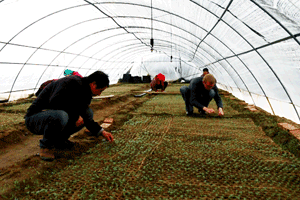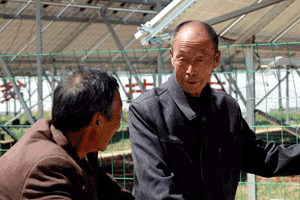No 1 Document for 2010
III. Accelerating the improvement of people's livelihood in rural areas to narrow down the gap in public utility development between urban and rural areas.
13. Increase farmer employment and help them start their own businesses. Build a public employment service system that covers both the urban and rural areas. Carry out agricultural technological training and alternative vocational training to enhance farmers' capacity in scientific farming and other employment. Develop high-value agriculture and integrated forestry-crop–livestock operations based on local conditions. Upgrade township and village enterprises (TVEs) and adjust their industrial structures, support the development of agro-processing industries, and actively develop agricultural tourism, forestry tourism and rural service industry so as to expand opportunities for non-farm employment in rural areas. Improve policy measures to encourage rural residents to start their own businesses. Migrant workers that have returned to the countryside and local farmers are both covered by the support policies. Improve guidance and services to help farmers seek employment in other regions, safeguard the legitimate rights of migrant workers and facilitate the smooth and orderly transfer of rural labor to cities. Improve social security system for migrant workers and extend the coverage of work injury insurance to all migrant workers. Strengthen the prevention and control of vocational diseases and provide health services for migrant workers. Migrant workers who have established a stable employment relationship with enterprises should be included in urban worker basic medical insurance program. Make sure that the urban worker basic old-age insurance (covering migrant workers) can be transferred across provinces. Solve the education problem of children of migrant workers by mainly relying on public schools and supplemented by other support from the receiving cities. Pay attention to and care for children left in the countryside by their parents.
14. Improve rural education, medical service, and cultural undertakings. Consolidate and improve rural compulsory education funding mechanism and implement teacher training system and performance-based salary system. The spatial distribution of rural schools should be such that it's convenient and safe for students to go to school. Continue to implement the middle school and primary school "safe school building project." Gradually improve student nutrition in poverty-stricken rural areas. Vigorously develop secondary vocational education and continue to move towards free secondary vocational education in rural areas. Further improve the three-tiered rural medical service network. Implement performance-based salary in township clinics and subsidies for village doctors for providing public health services. Gradually implement the plan to train general practitioners specifically for rural areas and recruit licensed medical professionals. Improve maternal and child care and disease prevention. Strengthen supervision of food and drugs in rural areas. Actively develop distance learning and distance medical service for rural areas. Maintain low birth rate in rural areas and continue to implement the new family planning policy. Improve award and assistance programs for some families complying with the family planning policy. Strengthen family planning service for mobile populations. Establish a stable funding mechanism for rural cultural undertakings. Continue to work to bring television and radio broadcasting to all villages. Promote cultural information resource sharing and integrated utilization of township cultural stations, film showings and rural bookstores. Carry out cultural and sport events for the masses.
15. Improve social security for rural residents. Gradually raise the level of funding, government subsidy and level of care of the new rural cooperative medical system. Link policies on new rural cooperative medical system, rural medical assistance, urban resident basic medical insurance and urban employee basic medical insurance systems. Continue with the pilot program on rural old-age insurance. Certain places with ripe conditions can speed up the piloting process. Encourage rural residents in the pilot areas to participate in the program and make sure those old residents who satisfy specific conditions can receive old-age pensions on time and in full amount. Set reasonable minimum rural standard of living and corresponding subsidy level and all those eligible for this subsidy should be covered. Implement and improve social security policies for farmers that have lost land to acquisition. Improve short-term aid system. Gradually raise the level of care for rural residents under the "five guarantee" (wubao) program. Build homes for the aged in rural areas and develop related services. Explore effective methods to address the issue of an aging rural population. Increase support and assistance to rural residents with disabilities in their production and life. All social security schemes in the rural areas should give priority to people with disabilities. Manage disaster prevention and mitigation in rural areas.
16. Strengthen the construction of water supplies, power suppliers, roads, gas supplies and housing. Provide guidance to the planning for constructing the "the new countryside" -- villages should have sound layout and complete functions. Put more resources into the "rural safe drinking water project". Strengthen water resource protection, water quality monitoring and project management. Encourage localities, if feasible, to build integrated water supply systems that cover both urban and rural areas. Given the trend of rapid increase in rural electricity demand, a new round of rural power grid upgrading needs to be implemented speedily to improve the reliability and capacity of power supply for rural areas. Continue to implement the "small hydropower for fuel" project and build more "new socialist countryside counties with hydro power for rural electrification." Complete rural road construction plans under the 11th Five-Year Plan, clarify responsibilities for rural road maintenance, and push for integrated urban-rural passenger transportation. Speed up the construction of biogas projects, including household-based biogas, large- and medium-sized biogas and concentrated biogas supply projects. Promote innovation in biogas technology and improve biogas maintenance services. Support the development of new energy sources and promote the use of agricultural waste as resources. Speed up the renovation of dangerous buildings in rural areas and the rebuilding of shanty towns in state farms and forest farms. Continue to implement the herdsmen settlement program. Given the rapid rise in rural housing construction and ample supply of construction materials, supporting farmers to build houses is a major measure to boost domestic demand. Take effective measures to increase building material sales in the countryside and encourage local governments to support farmers to build housing for their own use. Strengthen township and village planning and guide farmers to build safe, energy-efficient, environment-friendly housing with local, ethnic or traditional characteristics. Steadily push for comprehensive rural environment improvement. Carry out pilot projects in rural sewage system and river dredging and improve garbage and waste water management, so as to improve the overall living environment in the countryside. Take effective measures to prevent industrial waste from spreading to rural areas. Improve telecommunication and internet infrastructure in rural areas and improve the comprehensive rural information service system.
17. Continue the development-oriented poverty reduction work. Stick to the principle of "poverty reduction through development," increase resource input, and gradually expand the pilots on linking poverty reduction to minimum living standards subsidy. All low-income rural residents are to be covered by the poverty reduction policies, with a focus on building their own capacities to get out of poverty. Make sure that the growth rate of per capita rural income in the priority poverty reduction counties is higher than the national average. Make more efforts in implementing various poverty reduction programs such as "whole village advancement," rural labor training and transfer, poverty reduction through industrialization, and work-for-relief, so as to speed up infrastructure construction and the development of social undertakings in poverty-stricken areas. Carry out poverty reduction by relocation actively yet cautiously, and properly solve problems after resettlement. Carry out comprehensive management in poverty-stricken areas with special conditions. Expand the pilot programs in village-level mutual aid fund, regional development, and a lottery fund in support of the development of former revolutionary bases. Mobilize resources from all walks of life to contribute to poverty reduction. Actively carry out international exchange and cooperation in the field of poverty reduction. Formulate the guidelines for development-oriented poverty reduction in the next 10 years and make related plans.
- Typhoon Merbok to hit southern China coast Monday night
- Subgroups of BRICS brainstorm at meeting
- From imitation to innovation: China's fashion industry gets tech boost
- Nobel laureate heads Chinese institute on economics, AI application eyed
- Altay's isolation from railway network comes to an end



















